|
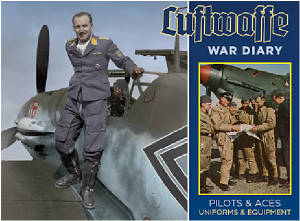
Luftwaffe War Diary:
Pilots & Aces: Uniforms &
Equipment
Visual history of the German Luftwaffe
fighter aces and their crew members in World War II.
Hundreds of color and b/w images of pilots and crews, aircraft, uniforms,
awards, sidearms, and more. Includes Stuka dive-bombers, Messerschmitt Bf 109 fighters, and other planes.
Must-have for
historians, modelers, World War II buffs, and aviation enthusiasts. Hardcover, size 11" x 8", Pages: 288, 400
color & b/w photos. Price - $39.95
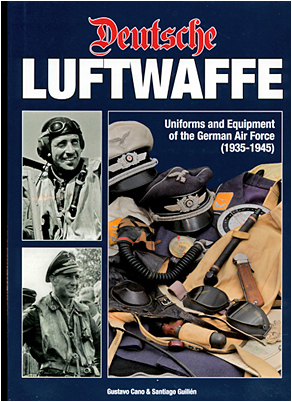
DEUTSCHE LUFTWAFFE:
Uniforms and Equipment of the German Airforce 1935-44 When
World War II began, Germany’s Luftwaffe was the most powerful air force yet seen, achieving victory after victory in
tandem with the German Army. But as other great powers rose to combat Hitler, the supremacy of the Me-109, Stuka, and Focke-Wulf
soon began to pale before vast fleets of Allied warplanes which German industry could hardly match.
Nevertheless,
while “flying till they died,” Luftwaffe pilots continued to write a record of heroism and innovation, until at
the very end of the war they nearly gained the edge again with their aces flying the world’s first jet fighter, the
Me-262.
In this large, lavishly illustrated, full-color work we gain an intimacy with the daily life of Luftwaffe pilots
as never seen before. From their uniforms to equipment to everyday sundries, drawn from incredible collections of memorabilia,
we can share their experiences on airfields or in the very skies of Europe, above the dark cause which unfortunately they
served. Size: 11.9"x8.4", Pages:310, Over 1,000 color and B+W photos. Price - $75.00
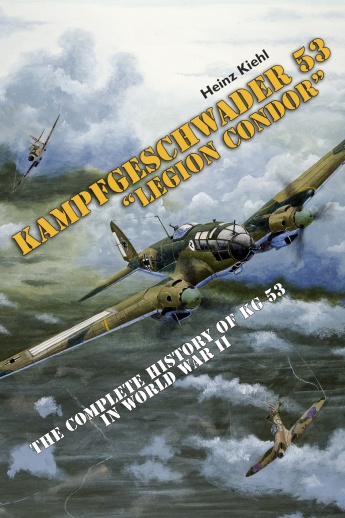
Kampfgeschwader 53 "Legion Condor": The Complete History of KG 53 in World War II Flying
Do 17, He 111, and Ju 88 aircraft, Luftwaffe bomber unit Kampfgeschwader 53 "Legion Condor" saw action in the campaigns in
Poland and France, the Battle of Britain, Russia, and finally over the invasion front. Towards the end of World War II, the
He 111 aircraft of KG 53 served as flying launch platforms for the infamous V-1 in dangerous missions against England. The
author – a former member of the Geschwader – accurately documents the unit’s formation, development, and
combat operations and brings it to life through gripping personal accounts and historically valuable photographs. This book
is one of the few books in English on the wartime operations of a German bomber unit and an indispensable addition to Luftwaffe
history. Size: 6" x 9" | 130 illustrations | 384 pages, Coast - $39.99
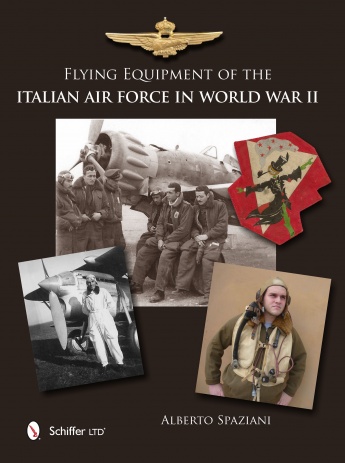
Flying Equipment of the Italian Air Force in World War II: Flight Suits • Flight Helmets • Goggles •
Parachutes • Life Vests • Oxygen Masks • Boots • Gloves This book is
a highly detailed look at World War II era Italian flight gear. Much of the information appears here for the first time in
English. Covering flight suits, flight helmets, goggles, parachutes, life vests, oxygen masks, boots, gloves, and more, in
over 600 images, offering full coverage of this long overlooked topic. Color photography shows full views of actual period
clothing and equipment, as well as close-up details of manufacturers' marks and labels, zippers, buttons and snaps, and insignia.
War era images, including rare period color, show Italian aircrews wearing a variety of Italian and German flight gear. Size:
9" x 12" | 700 illustrations | 240 pages, Coast - $69.99
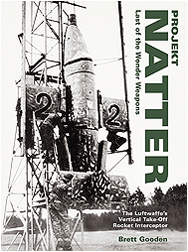
New
PROJEKT NATTER: Last of the Wonder Weapons
The Luftwaffe's Vertical Take-off Rocket Interceptor
In 1944, in response to the bombing of German cities and factories by the Allies, an inventor named Erich
Bachem developed "Projekt Natter" ("Viper"), an extraordinary, highly-secret, vertical take-off, semi-expendable, single-seat
rocket-fighter armed with a nose-mounted "honeycomb" of 73-mm or 55-mm spin-stabilized air-to-air rockets as well as 30-mm
cannon. The Natter was intended to offer high-speed defense of key targets. Once blasted into the air
from its vertical launch tower, the pilot of the Natter was to climb towards an enemy formation using an internal rocket,
target an enemy bomber and fire his battery of rockets. He would then use the remaining kinetic energy to climb higher than
the bombers in order to mount a ramming attack. Just before impact, the pilot was to trigger a mechanism that would activate
an ejection seat and separate the rocket unit, which would return to earth by means of an automatically deployed parachute
for reuse. Relatively little has been published on the Natter and this book will provide a detailed and
definitive account of this unusual but fascinating aircraft. This will be required reading for all those interested in the
history of the Luftwaffe during World War II, particularly for those fascinated by the radical and revolutionary projects
which German aircraft designers contrived toward the end of the Nazi regime. Hardcover, 9" x 12",
144 pages, 170 b+w and color photos.(rzm) Price: $44.95
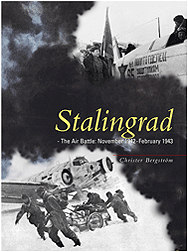
New
STALINGRAD:
The Air Battle: November 1942-February 1943
Following the harsh winter of 1941/42, the Germans renewed their offensive operations across the entire Eastern
Front once the spring thaw had set in. As in 1941, they made significant advances, particularly on the southern half of the
front, penetrating to the River Volga and the city of Stalingrad. The battle for Stalingrad was undoubtedly one of the turning
points in the war. Before the German defeat there and at the battle of El Alamein, they had never been beaten. After these
defeats, the Germans never again achieved a significant victory. While the land battle for Stalingrad is well known, the air
battle fought by the Luftwaffe and the Soviet air force is less well documented but was very important in determining the
ultimate fate of the city and the opposing combatants.
This book covers the significant air battles which took place over Stalingrad between August and November
1942 and the subsequent airlift operation in the winter of 1942/43 intended to relieve the German Sixth Army, which was by
then trapped in Stalingrad. It also covers the air war during the Russian counter-offensive in early 1943 where the Luftwaffe
played a major role in saving the whole German Eastern Front (and thus the whole German war effort) from collapsing. This
is an aspect of the war in the East that has previously not been covered in such depth. The strength of the author's writing
lies in its detail and his ability to tell the story from the viewpoint of both sides. Hardcover, 9" x
12", 144 pages, 125 b+w and color photos. (rzm)Price: $49.95
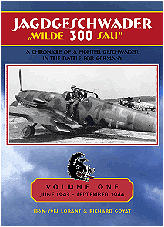
New
Jagdgeschwader 300
"Wilde Sau" Vol.1
A Chronicle of a Fighter Geschwaderin the Battle for Germany
The Wilde Sau Geschwader JG 300 played a key role in the aerial defense of the Reich during the last two
years of WWII but has never before been the subject of a serious and detailed study until now. This work thus fills a major
void in the history of the war in the air. This chronicle has been assembled with the participation of more than 130 veterans
and their families, traced and interviewed in the course of more than twenty years research. It sheds new light on flying
operations and aerial combat as experienced by German fighter pilots in the battles that took place over Germany. Interspersed
with numerous vivid personal accounts, it is a work that has a uniquely human and personal dimension. The
authors have undertaken an in-depth comparative study of German, British and American primary sources and archival records,
with the chief aim of minimizing errors and inaccuracies and ruling out dubious information. Far from seeking the 'glorify'
German or Allied aviators, they have reconstructed as accurately as possible the fates of the actors in this immense human
drama and pay them due tribute. This history of JG 300 also deals with those aspects of the air war often neglected in the
specialist literature such as the daily routines of the ground personnel and the navigation methods practiced by single seat
fighters. Included are comprehensive loss and victory listings, and more than 800 photographs in the two volumes collected
from private sources. Over 40 color profiles and paintings by Thomas A. Tullis and Richard Goyat are planned.
Hard Cover, Size: 8½" x 11," 400 Pages, 800 photos and color plates. (rzm)Price: $75.00
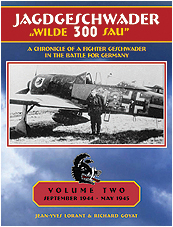
New
Jagdgeschwader 300
"Wilde Sau" Vol.2
A Chronicle of a Fighter Geschwader
in the Battle for Germany Setember 1944 - May 1945
The Wilde Sau Geschwader JG 300 played a key role in the aerial defense of the Reich during the last two
years of WWII but has never before been the subject of a serious and detailed study until now. This work thus fills a major
void in the history of the war in the air. This chronicle has been assembled with the participation of more than 130 veterans
and their families, traced and interviewed in the course of more than twenty years research. It sheds new light on flying
operations and aerial combat as experienced by German fighter pilots in the battles that took place over Germany. Interspersed
with numerous vivid personal accounts, it is a work that has a uniquely human and personal dimension.
The authors have undertaken an in-depth comparative study of German, British and American primary sources
and archival records, with the chief aim of minimizing errors and inaccuracies and ruling out dubious information. Far from
seeking the 'glorify' German or Allied aviators, they have reconstructed as accurately as possible the fates of the actors
in this immense human drama and pay them due tribute. This history of JG 300 also deals with those aspects of the air war
often neglected in the specialist literature such as the daily routines of the ground personnel and the navigation methods
practiced by single seat fighters. Included are comprehensive loss and victory listings, and more than 800 photographs in
the two volumes collected from private sources. Over 40 color profiles and paintings by Thomas A. Tullis and Richard Goyat
are planned. Hard Cover, Size: 8.5" x 11," 376 Pages, 800 photos and color plates. (rzm)Price: $85.00
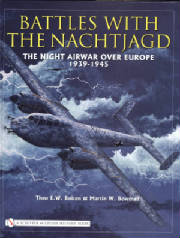
New
Battles with the Nachtjagd
The Night Airwar over Europe 1939-1945
Battles of the Nachtjagd traces the parallel developments in RAF night-bombing and night-fighting
in the Luftwaffe, from the pioneering efforts on both sides in this new form of airwar up to the climax of the strategic bombing
offensive in 1945 and the simultaneous introduction of the Me 262 jet in the German night fighter arm. The authors have traced
surviving aircrew from both sides and have succeeded in matching many Bomber Command losses to German night fighter claims.
Above all this book is the gripping story of the German night fighter versus bomber war over the Third Reich 1941-1945. There
are contributions from scores of veteran RAF and Commonwealth aircrew and their German adversaries, which shed new light on
many aspects of the giant and deadly nocturnal battle over northwestern Europe. The narrative is extensively illustrated with
more than 400 rare and mostly unpublished photographs from the personal collections of the veterans‚ wartime albums,
which grippingly illustrate the strategic and tactical developments in this most deadly struggle. Size: 8.5"x11", over
420 b/w photographs , 336 pages. (sch) Price - $59.95
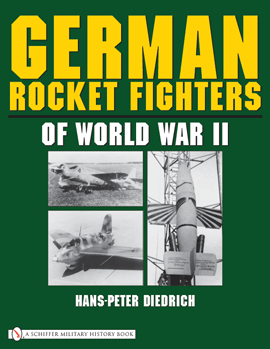
New
German Rocket Fighters of World War II
This book is the first to present every rocket aircraft flown in Germany and the rocket systems developed
by Walter and BMW, as well as several of the most interesting projects drawn up by Germany’s aviation industry. In 1940
the Deutsche Forschungsanstalt für Segelflug launched the DFS 194, developed by Alexander Lippisch, and the tests with this
experimental plane laid the foundation for the Messerschmitt Me 163, the world’s first operational rocket fighter. Using
a Walter rocket engine, the Me 163 achieved hitherto unimaginable climb rates and speeds. It was in this rocket powered plane
that, on 2 October 1941, Heini Dittmar reached 1003 km/h and thus became the first pilot in the world to break the magic mark
of 1000 km/h. In so doing, he also brushed against the sound barrier. The technology incorporated into Germany’s rocket
planes – the Messerschmitt Me 163 Bs and Cs, the Me 263, and Bachem Ba 349 Natter – was recognized throughout
the world as cutting edge and after the war had a major impact on the technological development of other countries. This book
is a must-have for every aviation enthusiast. Size: 8.5"x11", 90 b/w photos, line drawings, 152 pages. (sch) Price - $49.95
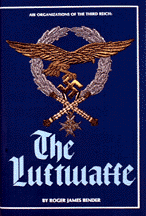
Air Organizations of the Third Reich
Book covers Luftwaffe rank insignia, Waffenfarbe, uniforms, headgear, cuff titles/armbands, special uniforms,
Fallschirmjger equipment, accessories, specialty badges, clasps, decorations, standards, flags, pennants, aircraft markings.
Size: 6"x9", over 200 photos, 320 pages. (sch) Price - $39.95
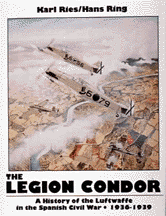
The Legion Condor 1936-1939
This classic book now makes its first appearance in English. Long out-of-print this study
is one of the few books dedicated to the history of the infamous Legion Condor, the German volunteer unit that fought with
pro-Franco forces during the Spanish Civil War from 1936-1939. Many of the tactics and strategies of the Luftwaffe were first
formulated and used during operations in Spain. Also, various aircraft were tested and used, such as the famous Ju 87, Do
17, He 111 and Bf 109 - all stalwarts of the later Luftwaffe during World War II. Many Luftwaffe pilots received combat training
in Spain; Werner Molders and Adolf Galland first earned their wings as members of the Legion Condor. Renowned Luftwaffe experts
Karl Ries and Hans Ring have brought together over 480 photographs, including aerial reconnaissance photos, detailed unit
insignia, and action shots. The history of the Legion Condor is discussed in great detail, including the many personalities,
thorough battle analysis, and technical aspects of the weaponry. The result is a superb historical study of the early Luftwaffe.
Karl Ries is the author of many books on the Luftwaffe including Luftwaffe Rudder Markings 1936-1945 with Ernst Obermaier,
available from Schiffer Military History. Hans Ring is co-author with Werner Girbig of a unit history of JG 27. Size: 8.5"x11",
Illustrations throughout, 288 pages. (sch) Price - $37.50
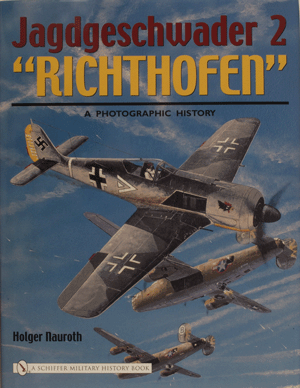
Jagdgeschwader 2 “Richthofen”
The legendary World War II Luftwaffe fighter unit Jagdgeschwader 2 “Richthofen” is the subject
of this new, large-format, illustrated volume. Tracing their history back to World War I fighter ace Manfred von Richthofen
(the legendary “Red Baron”), JG 2 was at the forefront of aerial combat. Flying the Messerschmitt Bf 109 and the
Focke-Wulf Fw 190 fighters during World War II, JG 2 produced many famous aces – among them Wilhelm Balthasar, Walter
Oesau, Egon Mayer, Hans Hahn, Erich Rudorfer, and Helmut Wick. Using a day-to-day chronology, the book covers JG 2’s
combat history during the early campaigns in Poland and France, through the Battle of Britain, North Africa, and in the later
defense of the Reich battles. A short chapter also covers their post-World War II transformation to JG 71 “Richtohofen”
under the command of Erich Hartmann, when they flew the F-86, F-104 and F-4 Phantom. Size: 8.5"x11", over 680 b/w photos,
352 pages. (sch) Price - $69.95
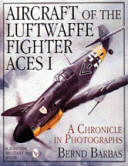
Aircraft of the Luftwaffe Fighter Aces I Volume I covers: JG 1 Oesau, JG 2 Richtofen, JG 3 Udet, JG 4, JG 5 Eismeer, JG 6 Horst Wessel, JG 7 Nowotny,
JG 11, JG 26 Schlageter, JG 27, JV 44, JG 51 Molders, and JG 52. Size: 8.5'X11", over 700 color and b/w photos, 264 pages.
(sch) Price - $49.95
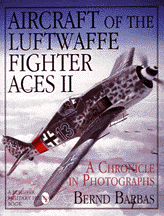
Aircraft of the Luftwaffe Fighter Aces II
Volume II covers: JG 53 Pik-As, JG 54 Grnherz, JG 77 Herz-As, JG 300, JG 301, JG 302 Wilde Sau, and JG 400.
Size: 8.5"x11", over 700 color and b/w photos, 208 pages. (sch) Price - $49.95
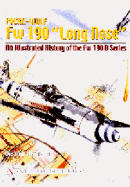
This book covers the complete development history of those variants of the Focke-Wulf Fw 190 powered by
inline engines. The first Fw 190 equipped with a Daimler Benz liquid-cooled engine took to the air in early 1942, followed
six months later by another powered by a Jumo 213. Production of the Fw 190 C, Fw 190 D and Ta 153 was delayed by the German
air ministry. Not until 1944, by which time Germany had lost control of the air, did the Fw 190 D-9, an interim fighter powered
by the Jumo 213 A, enter production. The Fw 190 D-9 proved an immediate success, largely due to an excellent prototype test
program under Dipl.Ing. Hans Sander. The type quickly entered service with the Luftwaffe and more than 1,700 examples were
completed by the end of the war. 208 pp., over 250 black and white, drawings, charts, color aircraft profiles, Large Format
Hardback. (sch) Price: $59.95
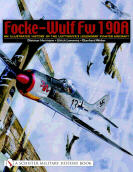
This book deals with the development history and testing of this fighter aircraft and production of the
early variants of the Fw 190 A. An interesting comparison between the Bf 109 and the Fw 190 shows the strengths and weaknesses
of the two aircraft, and authentic reports by former test pilots of Focke-Wulf and the Rechlin Test Station document the aircraft’s
performance. Also covered are the later torpedo-carrier and reconnaissance versions of the Fw 190. Together with the Messerschmitt
Bf 109, the Focke-Wulf Fw 190 formed the standard equipment of the German fighter arm in the Second World War and today is
considered one of the most capable fighters of that period. Initial flight trials in 1939 revealed a number of shortcomings,
nevertheless the basic concept of the Fw 190 proved extremely successful. 224 pp., over 340 b/w and color photographs, profiles,
line schemes, Large Format Hardback. (sch)
Price: $59.95
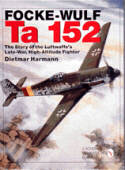
From the time of its appearance in 1939 the Focke-Wulf Fw 190 was one of the best fighter aircraft of WW
II - a masterpiece produced by chief designer Kurt Tank. In 1943 he developed a new fighter aircraft based on this successful
concept. The project soon deviated far from the original Fw 190 concept and as an honor to the designer it was designated
the Ta 152. The Ta 152 could stand up to the best Allied fighter aircraft, such as the P-51 Mustang. The heavy Allied bombing
at the end of the war prevented production from beginning as planned, and as a result only a few Ta 152Hs could be delivered.
144 pp., over 165 b&w photographs and line drawings. Large Format Hardback. (sch) Price - $35.00
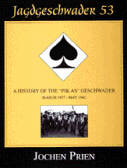
March 1937 - May 1942
JG 53 - or as it was better known,
the "Pik As" (Ace of Spades) Geschwader - was one of the oldest German fighter units of World War II with its origins going
back to the year 1937. This first volume, of a planned three volume set, covers the early years of the Geschwader from its
founding in the spring of 1937 up to May of 1942. This book appears here for the first time in English, and contains over
200 additional photos not published in the original German language edition. Size: 9"x12", over 700 color and b/w photos,
drawings and maps,400 pages. (sch) Price - $89.95
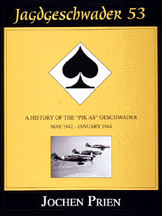
Jagdeschwader 53
A History of the "Pik As" Geschwader Volume 2: May 1942 - January 1944
Jagdgeschwader 53 – or as it was better known, the “Pik As” (Ace of Spades)
Geschwader – was one of the oldest German fighter units of World War II with its origins going back to the year 1937.
This second volume, of a three volume set, covers from May 1942 to January 1944. As with the first volume, this book also
appears for the first time in English, and contains over 100 additional photos not published in the original German language
edition. The book contains over 450 photographs, revised text and maps, and aircraft line drawings, as well as updated aerial
victory and loss listings. This second part of the narrative begins in May 1942 when after the termination of the German air
offensive against the British island fortress Malta the “Pik As” Geschwader was split up with its three Gruppen
scattered over three different theatres of operation. I./JG 53 was moved to the eastern front, where it was to take part in
the German summer offensive in the southern sector aimed at Stalingrad and the Caucauses. Meanwhile III./JG 53 saw service
in North Africa where it was to support Rommel’s planned advance on Cairo. Stab and II./JG 53, which were left behind
on Sicily after the end of the “Malta Blitz” in May had since seen continuous service over Malta and the central
Mediterranean in the vain effort of the Axis Air Forces to hold down the British air and naval forces and to prevent them
from interfering with the Axis supply shipping to and from North Africa. The second half of 1943 saw German forces retreating
north through Italy. During these months JG 53 saw continuous action over southern Italy with losses mounting alarmingly to
an unprecedented level and at the same time with little success in spite of the Geschwader’s unimpaired stubbornness.
This volume ends in the winter of 1943/44. Volume 3 will cover from January 1944 to the end of the war. Size: 9"x12", over
450 b/w and color photos, line drawings maps and charts, 352 pages. (sch) Price - $89.95
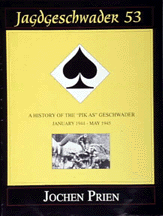
Jagdeschwader 53
A History of the "Pik As" Geschwader Volume 3: January 1944 - May 1945
This third and final part of the narrative starts with the bitter fighting over Italy, where
the Geschwaderstab together with I. and III./JG 53 had to face overwhelming odds in their struggle over both the front lines
at Cassino and Anzio/Nettuno bridghead, and over northern Italy. I./JG 53 was later moved to Romania in order to protect the
vital oilfields and refineries around Ploesti and later saw further action in Hungary, where it was to take part in the fierce
fighting on the southeastern part of the Russian Front in the fall of 1944 and early 1945, eventually retreating into Czechoslovakia
and Austria before it was finally disbanded in April 1945 – its remnants amalgamated into II./JG 52. II./JG 53, withdrew
from Italy in October 1943, and was the first Gruppe of the Geschwader to be employed on home defense operations, being stationed
near Vienna from October 1943 to March 1944 before moving to southwestern Germany, and was the only Gruppe of JG 53 to see
action against the Allied invasion forces in the summer of 1944. III./JG 53 also returned from Italy in June 1944 and after
a short period of rest and refit was active in the defense of the Reich. When the Allies launched Operation Market Garden
both II. and III./JG 53 were called upon to take part in defensive actions. Autumn of 1944 also saw the addition of a fourth
Gruppe to the Geschwader with Stab, II., III., IV./JG 53 based along the southwestern sector of the Western Front. For the
remainder of the war the Geschwader – minus I. Gruppe – stayed in the southwest where it fought on until the end,
retreating deep into southern Germany where the majority of the Gruppen and Staffen were finally disbanded a few days before
VE-Day. This final volume of the epic saga of JG 53 concludes with a list of the officers in command of the Geschwader, its
Gruppen and Staffeln, a listing of all known victories claimed by JG 53, strength returns, and other appendices. Size: 9"x12",
over 315 b/w photos, line drawings, profiles, 464 pagea. (sch) Price - $89.95
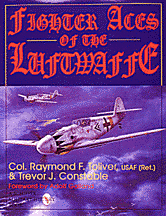
Fighter Aces of the Luftwaffe
The most successful fighter pilots of all time spring to vibrant life again in this revised
and updated edition of the classic account of Germany's greatest aces in action. Ride into combat with such Luftwaffe luminaries
as ace of aces Erich Hartmann, Gunther Rall, Gerhard Barkhorn and dozens of others as they provide first-hand accounts of
the German fighter arm's epic battle for the skies over Europe, Africa, and Russia. Accurate pen portraits illuminate outstanding
fighter leaders and tutor like Werner Molders, Adolph Galland, "Macky" Steinhoff and many more, who invested the Luftwaffe
Fighter Arm with its characteristic spirit and vigor. Legendary air heros like Marseille, and mercurial "Star of Africa",
are shown in hundreds of photos from German collections. Personal combat accounts appear against the backdrop of Reichsmarschall
Hermann Goring, who undermined his own pilots. From early aerial ascendancy, followed by its triumphant assault on the Red
Air Force, the Luftwaffe Fighter Arm was inexorably crushed by overwhelming Allied air power. Unquenchable courage, devotion
to the defense of their country's civilians, and unmatched combat skills were of no avail. The great aces, even in Germany's
revolutionary Me 262 jet fighter, could not win, yet they fought to the final hour in an unforgettable combat saga. All of
it is here, exactly as it was lived by the German aces. This book is considered by surviving Luftwaffe aces to be their monument.
Also included are data lists covering all known Luftwaffe aces, night fighter aces, jet aces, and tops & firsts. Size:
8.5"x11", over 600 photos, 352 pages. (sch) Price - $49.95
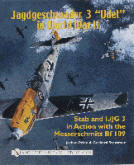
Jochen Prien, author of the definitive Messerschmitt Bf 109 F/G/K Series, and the extensive three volume
study of JG 53, presents JG 3 in its complete history from formation to the end of World War II. This volume begins with a
brief account of the Stab from the time of its formation in 1938 until it reequipped on the Fw 190 in the summer of 1944,
then follows the operational history of I Gruppe, beginning with the first unit to bear the designation I/JG 3, which was
formed in autumn 1938, fought in the French campaign, the Battle of Britain, and Operation Barbarossa, and then in January
1942 was redesignated as II/JG 1 and left the Geschwader to join Jagdgeschwader 1, then being formed. 400 pp., over 350 black
and white photographs, line drawings, Large Format Hardback. (sch) Price - $69.95
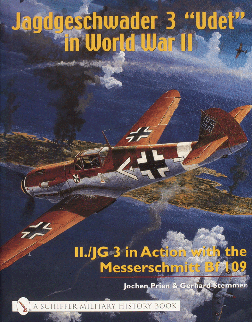
Jagdgeschwader 3 Udet in World War II
|
II./JG 3 in Action with the Messerschmitt Bf 109
Jochen Prien, author of the definitive Messerschmitt Bf 109 F/G/K Series, and the extensive three volume study
of JG 53, presents JG 3 in its complete history from formation to the end of World War II. This second volume presents the
unit history of the "Udet" Geschwader's second Gruppe, II./JG 3, beginning with its formation in early 1940 and the subsequent
service of the newly formed Gruppe in the Campaign in the West from 1940-1941. Next the Gruppe's 1941 tour of duty in Russia
is dealt with, followed by a short spell in the Mediterranean theatre of war, where II./JG 3 was involved in the fighting
over Malta in the spring of 1942. In June 1942, the Gruppe was again shifted to the east where it took part in the advance
on Stalingrad where it suffered serious losses. 1943 saw the Gruppe still in Russia until it was recalled to the Reich to
see further service in the defence of Germany between August 1943 and early June 1944. After its return to the Reich and a
short period of rest and re-equiping, II./JG 3 was again called upon for service in the Reichsverteidigung, this coming to
an abrupt end when in November 1944 the Gruppe was separated from its parent Geschwader in order to re-equip with the new
Me 262 jet fighter and become part of the first jet fighter Geschwader of the Luftwaffe, JG 7. Vol. II then takes up the history
of the newly formed II./JG 3, a former bomber unit that was transformed into a fighter Gruppe at the end of 1944; this new
Gruppe came too late to see significant service against the Western Allies but was transferred to the east at the beginning
of 1945 in order to counter the massive Soviet offensive that overran the eastern parts of the Reich since mid-January 1945.
Hopelessly outnumbered, its operations being curtailed now by a lack of fuel, the new II./JG 3 struggled on until the collapse
of the Reich. Size: 8.5"x11", over 350 b/w photos, line drawings, 400 pages. (sch) Price - $69.95 |
 |
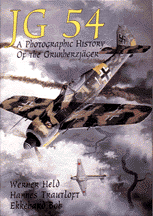
JG 54
A Photographic History of the GrunherzjŠger
In five turbulent years the members of this highly successful Luftwaffe fighter unit developed
into such a close-knit team that even now - almost fifty years later - that bond still exists. This unique photo history was
compiled with assistance from the air and ground crews of JG 54. The 400+ photographs document the story of the Grunherz-Geschwader
from its formation in the spring of 1939 to the final battles in the courland pocket in the spring of 1945. Within the timespan
lay the arduous years of operations in Poland, France, the Channel Front, the Balkans, Russia, Finland and the defense of
the Reich. Werner Held is the author of many books on the Luftwaffe of World War II including The German Fighter Units over
Russia, and the Luftwaffe in the North African Campaign (both available from Schiffer Publishing). Hannes Trautloft is a former
Geschwaderkommodore of JG 54. Ekkerhard Bob is a former Staffelkapitan in JG 54. Size: 7"x10", over 400 b/w photos, 196 pages.
(sch) Price - $29.95
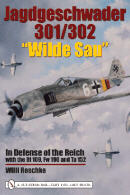
Jagdgeschwader 301/302 Wilde Sau: In Defense of the Reich with the Bf 109, Fw 190 and Ta 152Jagdgeschwader 301 and 302 were established in 1943. Their mission was to intercept enemy bombers at night
flying fast single-engined fighters. But they also had to engage Allied bombers by day. The pilots of these new fighter wings
were a mix of former bomber pilots and trained fighter pilots – a unique composition for the Luftwaffe. Night missions
required good instrument training, like that given to bomber pilots. The fighter pilots were more familiar with the available
aircraft and combat tactics. A former fighter pilot himself, Willi Reschke describes the difficulties of crossing over from
day to night fighting and vice-versa. He describes the difficult missions flown by JG 301/JG 302 and the fates of their pilots,
providing the first chronicle of the “Wilde Sau” Geschwader. 288 pp., over 120 b/w photographs, victory and loss
lists, Hardback. (sch) Price - $39.95
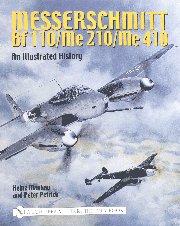
Messerschmitt Bf 110/Me 210/Me 410
An Illustrated History
For the first time, this richly illustrated book offers a comprehensive, detailed examination
of the legendary Messerschmitt Bf 110, Me 210, and Me 410 series. By 1935 the Bf 109 had made Messerschmitt the leading manufacturer
of fighter aircraft in Germany. The twin-engined Bf 110 followed on its heels in 1936, a type the Luftwaffe took on in large
numbers as a long-range fighter, heavy-fighter, fighter-bomber, night-fighter and reconnaissance platform. As its successor,
Messerschmitt developed the better performing Me 210, which flew for the first time in 1939. But this airframe soon began
manifesting serious design flaws, and accidents with the Me 210 quickly started piling up due to the type's questionable flight
handling characteristics. The Luftwaffe refused to accept any more aircraft as a result, and at a stroke the type's overzealous
full scale production ground to a halt. More powerful engines and a number of design changes saw this aircraft produced from
1943 to 1944 under the designation of Me 410, and as such the type gave an excellent accounting of itself in service with
the Luftwaffe. Size: 8.5"x11", over 350 b/w photos and line drawings, 360 pages. (sch) Price - $69.95
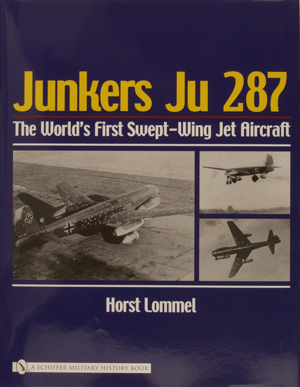
Junkers Ju 287
The World’s First Swept-Wing Jet Aircraft
In the summer of 1944, as the Second World War drew to a close, an unusual airplane took to
the skies over Leipzig-Brandis on its maiden flight. It was the prototype version of the Ju 287 V1, a four-engine jet bomber.
With its forward swept wings, the design was a critical milestone in the annals of aviation technology and made the Ju 287
the first swept-wing design in the world. One of the world’s most interesting airplanes is revealed through many previously
unpublished reports, photographs and drawings. It is an airplane whose revolutionary design played a major role in the postwar
development of jet aircraft, in both the East and the West. This book fills a gap in the material covering the first chapter
of the jet era. Size: 8.5"x11", over 300 b/w photos, 224 pages. Price - $49.95
|



